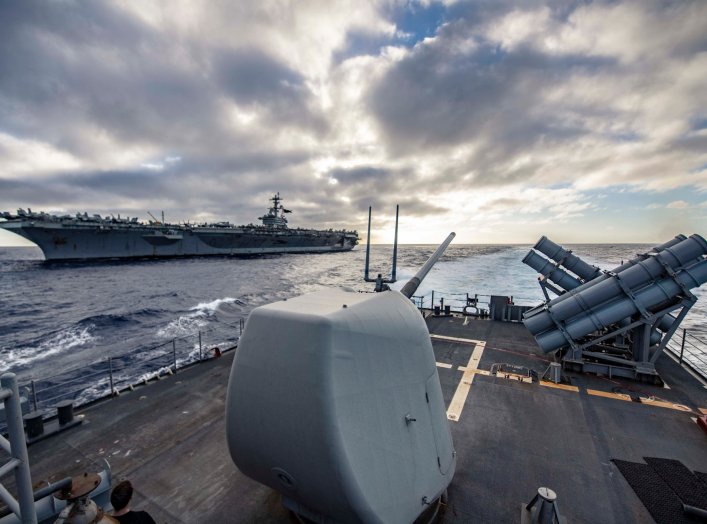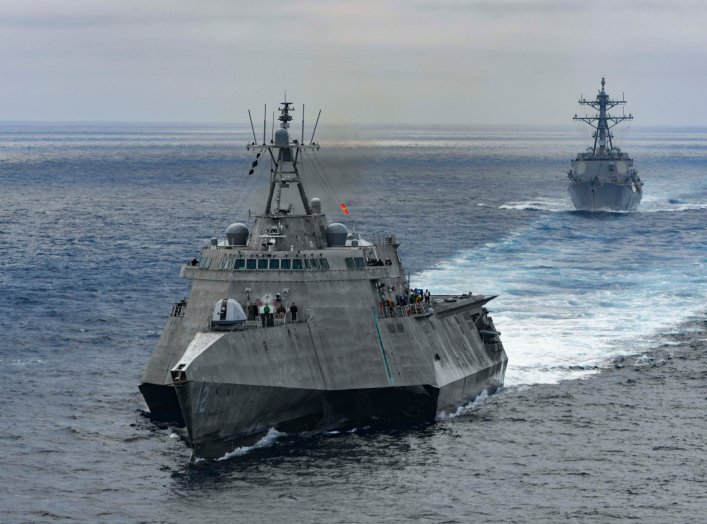
This multi-beam integration is what helps facilitate the simultaneous tracking of several threats at once, as it can synthesize horizon scanning and precision tracking with wide-area volume search and Ballistic Missile Defense discrimination. Discrimination is of course a vital advantage associated with increased radar sensitivity, as it can discern threat objects from other less-relevant items such as friendly platforms or flying debris.
The Navy is moving quickly to integrate a new family of tailored radar systems across the fleet as part of a coordinated effort to stop dangerous attacks from farther distances and stop multiple attacks at the same time. The service is integrating its emerging AN/SPY-6 family of radar systems onto its Flight III DDG 51 destroyers and also tailoring variants of the technology for amphibs, Frigates and Carriers.
There are many attack scenarios wherein anti-ship missiles, aircraft and even ballistic missiles can be fired by enemies in a coordinated fashion, requiring defensive technologies to detect and discriminate multiple threats at one time.
The new radars are much more sensitive, longer range, and engineered to discriminate threats from one another. The current SPY-6 integration initiative, now underway at a rapid pace, is changing Navy surface warfare tactics, according to The Navy’s Above Water Sensors Program Manager, Capt. Jason Hall.
Hall said multiple track functionality, signal processing and increased sensitivity provide “the heart” of how SPY-6 radars change tactics for ocean warfare.
“We are looking at how you get after the increased capability that it (SPY-6 radar) brings, vs. the SPY-1 (current AN/SPY-1) legacy system. We have run the gamut as to what this radar can do,” Hall said in January of this year at the Surface Navy Association Symposium, Arlington, Va.
Hall further explained that the SPY-6 radar systems, combined with fire control and an advanced software-ballistic missile defense system called Aegis Baseline 10, set the technical foundation for the fleet. “We will be leveraging this combat system as we look at Frigate, amphibs and carriers,” Hall said.
Multiple-track sensing and detection is expected to bring the desired radar detection strategy, as SPY-6 radars combine air-warfare and ballistic missile defense into a single system. When it comes to application, the SPY-6 radar systems streamline otherwise disparate fire-control and detection technologies; the SPY-6 can cue short-range, closer-in interceptors as well as longer-range ballistic missile interceptors such as an SM-3. This shortens the sensor-to-shooter time and offers war commanders a longer window with which to make decisions about which countermeasure is needed. This integration is precisely the kind of defense needed to counter a multi-pronged, coordinated enemy attack potentially combining ballistic missiles with cruise missiles, drone attacks...and more.
The SPY-6 family moves beyond existing AN/SPY-1 ship-integrated radar system and, according to an interesting essay in "Microwave Journal"..."handles 30 times more targets and has 30-times greater sensitivity than the SPY-1D(V).” (“Radar and Phased Array Breakthroughs,” Eli Booker)
Digital Beam Forming, according to Navy and Raytheon developers, can make multiple-track radar applications possible. An interesting essay in a publication called "RadarTutorial" explains how “multiple independent, narrow beams steered in all directions can be formed in the digital beamforming processor. This brings improved dynamic range controlling
The essay further describes that “adaptive digital beamforming and radar signal processing functionality further improve the radar’s ability to function in adverse conditions.”
Interestingly, the Microwave Journal essay specifically cites some of Raytheon’s digital beamforming technology… stating:
"….Raytheon is developing a mixer-less system with direct RF analog-to-digital conversion that has greater than 400 MHz instantaneous bandwidth and is reconfigurable, able to switch between S- and X-Band... -- Microwave Journal, “Radar and Phased Array Breakthroughs” (Eli Booker)
Hall addressed this synergy between multiple beams as involving “S-band radar, X-band radar and a Radar Suite Controller (RSC). RSC coordinates S and X band interfaces.” S-band, according to “Radartutorial,” provides wide-area volume search, target tracking, Ballistic Missile Defense discrimination and missile tracking. X-band, the essay describes, “provides horizon search, precision tracking, missile communications and final illumination of guidance to targets.”
This multi-beam integration is what helps facilitate the simultaneous tracking of several threats at once, as it can synthesize horizon scanning and precision tracking with wide-area volume search and Ballistic Missile Defense discrimination. Discrimination is, of course, a vital advantage associated with increased radar sensitivity, as it can discern threat objects from other less-relevant items such as friendly platforms or flying debris.
Raytheon’s SPY-6 radar transmitter uses a material known as military-grade Gallium Nitride (GaN), a substance explained by Raytheon developers as up to 1,000-times more efficient that the existing Gallium Arsenide used today.
“GaN converts electrical power into radar, creating greater efficiency which allows us to see a smaller object,” Scott Spence, Director for Naval Radar Systems for Integrated Defense Systems, Raytheon, told Warrior in an interview.
Alongside the SPY-6 (V)1, Raytheon and the Navy are now integrating several additional SPY-6 variants for carriers and amphibs, specifically tailored to their respective mission scopes. The SPY-6 (V) 2, for instance, is a smaller rotating radar and a SPY-6 (V) 3 has three fixed radar faces on the deckhouses. These variants will go on both Nimitz class and Ford-class carriers. The (V) 3 has nine radar module assemblies. The (V)3 has three fixed spaces looking out at a different angle, covering 360-degrees with 120-degree panels each. Finally, there is a SPY-6 (V)4 which will be integrated onto existing DDG 51 IIA destroyers during a mid-life upgrade. The (V) 4 has 24 Radar Module Assemblies, compared to the (V) 1, which has 37.
The use of a scalable antenna, composed of 2ft X 2ft X 2ft Radar Module Assembly building blocks, enables developers to engineer tailored, mission-specific, radar applications for different platforms.
A 2017 Pentagon Selected Acquisition Report, written earlier in the development process of the SPY-6 radar, explains that each RMA is comprised of four Line Replaceable Units (LRU). “Each LRU can be replaced in less than 6 minutes.The back-end radar controller is fully programmable and uses commercial off-the-shelf (COTS) 86 processors, which allows adapting to future threats, easy upgrades with future COTS processors and no obsolescence.” (Air and Missile Defense Radar (AMDR) As of FY 2017 President's Budget Selected Acquisition Report (SAR).
COTs processing equipment refresh “upgrades will be implemented using a ‘refresh by attrition’ approach… software updates,” the SAR Report states.
“We moved to a modular maintenance concept so that is a real big change. We are able to break down the elements themselves into modular structures …. then you can adjust form factor to whatever size you want,” Hall explained.
What all of this amounts to is … more time and options for Commanders tasked with ship defense. For instance, an approaching ballistic missile might likely require a longer-range SM-3 interceptor missile….a sea-skimming cruise missile might require an Evolved Sea Sparrow Block II interceptor …..and approaching enemy aircraft, helicopter or drone might require an SM-6, deck-mounted guns or even laser weapons...and fast-approaching small boats might require the Close-In-Weapons system -- all of which comprise different elements of a ship’s layered defenses. Advanced automation, and even human-controlled AI-enabled processing, sensors and networked fire control might quickly allow Navy ships to employ many of these to operate simultaneously in response to multiple tracks detected by SPY-6 radar.
The radar is built in a 30,000 square foot automated facility in Andover, Mass; Raytheon leads an industry team of more than 125 suppliers that build SPY-6. Virtual Tour HERE
Finally, it goes without saying that increased networking, computing speeds and signal processing require extensive “hardening” of networks, a reason why Hall stressed that the Navy is working closely with industry on cybersecurity.







